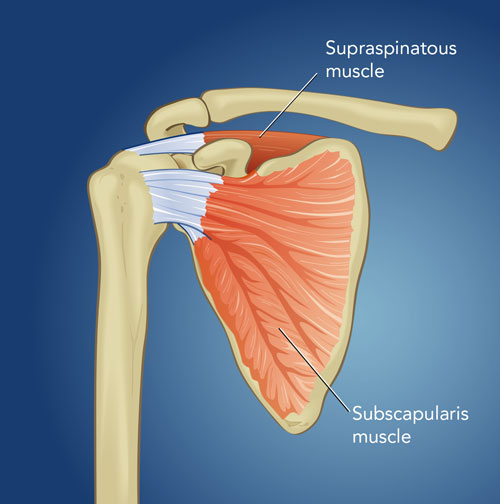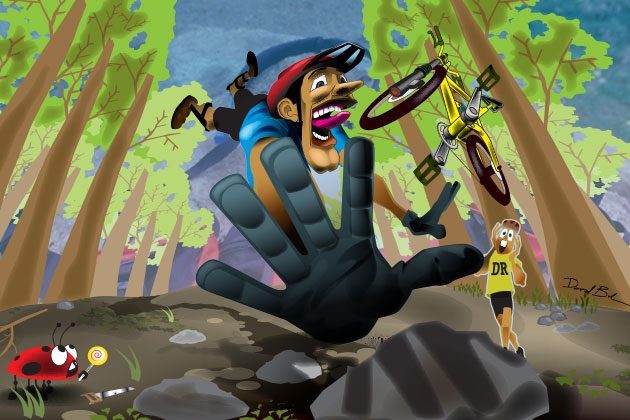Blast From the Past: Shoulder Owner’s Manual
Originally posted on April 21, 2016 at 7:00 amEditor’s note: This article originally appeared in Dirt Rag Issue #138, published in October 2008. Words by David Alden-St. Pierre, MS, PA-C. Medical illustrations by Kerry Nicholson. Crash illustration by David Biber.
You know the drill. Any number of things can send you flying through the air like Superman. Of course, Superman flies with his arms outstretched, maybe to steer, but certainly not to cushion the blow if he slams into the ground.
“Landing directly on your shoulder and outstretched arm can definitely send lots of stress to this joint,” says Tom Cookson, owner of Cookson Physical Therapy in Peabody, Massachusetts, an avid cyclist and runner for more than 30 years with 21 years experience as a sports and orthopedic physical therapist. According to Cookson, shoulder injuries that result from crashing are a common reason for riders ending up in his clinic.
Shoulders 101
Your upper arm bone (humerus) fits into a shallow cup (glenoid fossa) created by a ring of cartilage (labrum) on the shoulder blade (scapula). The shoulder blade connects on one end of the collarbone (clavicle) called the acromioclavicular joint, and the other end of the collarbone connects to the sternum at the sternoclavicular joint. In fact, the sternoclavicular joint is the only bone-to-bone connection for your entire arm and shoulder to the main part of your body. The shoulder is usually separated into two distinct units, the “girdle,” which includes the scapula and the clavicle, and the “joint,” which includes the scapula and the humerus.

The shoulder joint is typically classified as a ball-and-socket joint, but in reality, it’s more like a ball-on-a-saucer joint, meaning that the cup is not very deep. This is both good and bad for us. It’s good because this allows your arm to have a wide range of motion, but it’s bad because the shoulder can be fairly unstable.
If you put your arm straight out to the side, very little force is needed to pop your arm out of its socket from the back. Not that this type of injury commonly occurs from crashing, but that’s just to give you an idea of the instability. Likewise, when you land with your arms outstretched, say in a push-up position, the only thing holding your arms in their sockets are those very small rings of cartilage and soft tissue like muscles, tendons and ligaments.
Ligaments connect bone to bone, and the ones mainly injured in the shoulder from crashing are the ones at the acromioclavicular joint. When these ligaments are partially or totally torn, it’s called a separated shoulder. Depending on how bad the tears are, surgery may be required.
This differs from a dislocated shoulder where the head of the humerus pops out of its socket. The head of the humerus can partially dislocate, called a subluxation, or totally dislocate. In either case, once the ligaments and tendons are stretched, repeat injuries are very likely; the chance of tearing the labrum goes up as well. Some people can recover with physical therapy to strengthen the shoulder muscles that stabilize the joint, but others need surgery to tighten the ligaments and the joint capsule, and/or repair cartilage.
The muscles that stabilize and control the shoulder come from the chest, back, arms, neck and the shoulder itself. Four muscles, called rotator cuff muscles, are particularly important. They hold the head of the humerus in place, while other, stronger muscles move the arm.

Warning—Soft Shoulders
After spitting out the dirt and checking your bike, it’s time to see how badly banged up you are.
“A fractured clavicle or other injuries will normally result in immediate pain, and often there may be obvious deformity,” says Cookson.
A fractured clavicle, or broken collarbone, is one of the most common types of shoulder injuries for cyclists. One report showed that between 23 and 54 percent of crashes that resulted in broken bones involved the collarbone.
People who break their collarbone typically hold their arm protectively by their side, and the affected shoulder may look lower than the other one. In severe cases, the broken bones may be visible through the skin. If this happens, don’t try to use your arm (yeah, unless you’re Tyler Hamilton). You can make a makeshift sling out of an inner tube and then get to a hospital.
“Any injury with obvious deformity needs immediate medical attention,” says Cookson.
Not all shoulder injuries are caused by crashes, though. “Overuse injuries of the shoulder are less frequent; however, muscular fatigue is common for long distance riders and technical riders alike,” adds Cookson. This fatigue can weaken the joint, which can, over time, create instability, pain and/or swelling.
“Overuse injuries of the shoulder respond well to rest, anti-inflammatories and ice,” he says. “Ice should be used with a wet towel on the skin with the ice placed over the towel. If symptoms persist, an orthopedic evaluation and physical therapy can help to keep you on the bike. A proper bike fit can help to minimize the symptoms too.
“When I have patients who have been injured in the past and who are worried about re-injury, I like to have them work on rotator cuff exercises with an exercise band, moving to dumbbells as strength improves,” says Cookson, “followed by gradual progression of weight-bearing through the shoulder with a ‘push-up progression.’”
A push-up progression, Cookson explains, can start with vertical wall push-ups (just pushing against a wall), progressing to pushing against a counter or table, and ultimately to a regular floor push-up.
“This progression helps the shoulder to tolerate increased workloads, as long as you don’t progress to the next level if you are still experiencing pain; the ‘no pain, no gain’ ideology does not apply to upper body strengthening,” he says. Incorporating upper-body strength exercises into your training can help prevent injuries and enable you to recover more quickly.
“Learning to crash (tuck and roll) has been cited in several resources as an effective way to decrease trauma injuries in a fall,” adds Cookson. You can practice at a gym with padded flooring or in a grassy area. Of course, be very careful when you practice. Your friends will never let you live it down if you hurt yourself while practicing crashes. And if you know any lawyers, you didn’t hear the suggestion from us.
Keep reading
We’ve published a lot of stuff in 26 years of Dirt Rag. Find all our Blast From the Past stories here.
